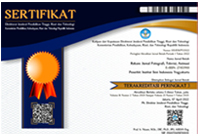Era Baru Televisi dalam Pandangan Konvergensi Media
Abstract
New Era of Television in the Perspective of Media Convergence. The development of internet technology has led to changes and developments in the world of mass communication. Because of the internet, new media emerges. The emergence of new media is changing the way people get information through the media. Initially, people got information and news through conventional media, such as newspapers, radio, or television. To be able to continue competing as a source of information demanded by the public, television media also innovates by converging. Convergence is a combination of several types of media and is present in the form of a digital platform. This research is a library research that aims to find out media convergence conducted by television media, especially in changing platforms from conventional television to digital media. Media convergence enables professionals in the mass media field to deliver news and present information and entertainment using a variety of media. The government as the regulator is fully responsible for creating regulations that can protect all elements of society from the bad influence of the media. Regulation becomes a logical consequence of the game of cultural symbols displayed by convergent media. The goal is clear, which is to avoid a conflict of interests that makes one party harmed, especially the users or the public, for they usually become the victim of the implementation of a convergence.
ABSTRAK
Perkembangan teknologi internet telah menimbulkan perubahan dan perkembangan dalam dunia komunikasi massa. Karena internet, muncullah media baru atau new media. Kemunculan media baru tersebut mengubah cara masyarakat mendapatkan informasi melalui media. Awalnya, masyarakat mendapatkan informasi dan berita melalui media konvensional, seperti surat kabar, radio, atau televisi. Untuk dapat terus berkompetisi sebagai sumber informasi yang diminati masyarakat, media televisi pun melakukan inovasi dengan cara berkonvergensi. Konvergensi adalah penggabungan dari beberapa jenis media dan hadir dalam bentuk platform digital. Penelitian ini adalah penelitian library research yang bertujuan untuk mengetahui konvergensi media yang dilakukan oleh media televisi khususnya dalam mengubah platform dari konvensional ke media digital. Konvergensi media memungkinkan para profesional di bidang media massa untuk menyampaikan berita dan menghadirkan informasi dan hiburan, dengan menggunakan berbagai macam media. Pemerintah selaku regulator bertanggung jawab penuh menciptakan regulasi yang dapat melindungi segenap elemen masyarakat dari pengaruh buruk media. Regulasi menjadi konsekuensi logis dari permainan simbol budaya yang ditampilkan oleh media konvergen. Tujuannya jelas, yakni agar tidak terjadi tabrakan kepentingan yang menjadikan salah satu pihak menjadi dirugikan. Terutama bagi kalangan pengguna atau publik, pihak ini biasanya menjadi pihak yang paling sering menjadi korban dari implementasi konvergensi.
Keywords
Full Text:
PDFReferences
Abrar, N. A. (2003). Teknologi Komunikasi: Perspektif Ilmu Komunikasi. Yogyakarta: LESFI.
Chen, G. M., & Kai , Z. (2010). “New Media and Cultural Identity in the Global Society” dalam Rotimi Taiwo (Editor) Handbook of Research on Discourse Behavior and Digital Communication: Language Structures and Social Interaction. New York: Information.
Cooper, C. (2018, Juni 24). Gates: Convergence is for Real. Retrieved from CNET.news.com: http://news.com.com/ 2120-7353-3-5137118.htm1
Hastjarjo, S. (2007). Teknologi Digital dan Dunia Penyiaran. Jurnal Komunikasi Massa UNS, Vol. 1, No. 1.
Jenkins, H. (2006). Convergence Culture: Where Old and New Media Collide. New York: New York University Press.
Romli, K. (2016). Komunikasi Massa. Jakarta: Grasindo.
Sari, M. K. (2016). Peranan Pemilihan Strategi dan Stilistika dalam Iklan di Televisi. REKAM: Jurnal Fotografi, Televisi, dan Animasi, 11(1), 19.
Suprihono, A.E. (2019). Sinematografi Wayang : Persoalan Transmedia Seni Pertunjukan Tradisional. REKAM: Jurnal Fotografi, Televisi, dan Animasi15(2), 131–145.
Severin, J. W., & James, W. T. (2001). Communication Theories: Origins, Methods, and Uses in Mass Media. New York: Longman.
Tapscott, D. (1996). The Digital Economy Era: Promise and Peril in the Age of Networked Intelligence. New York: McGraw Hill.
Zed, M. (2014). Metode Penelitian Kepustakaan. Jakarta: Yayasan Pustaka Obor Indonesia.
DOI: https://doi.org/10.24821/rekam.v16i1.3721
Refbacks

This work is licensed under a Creative Commons Attribution 4.0 International License.



